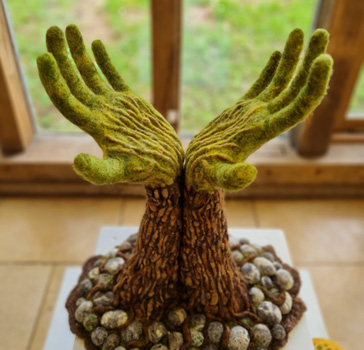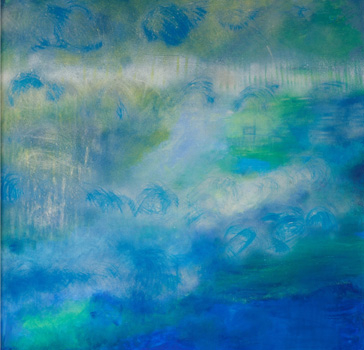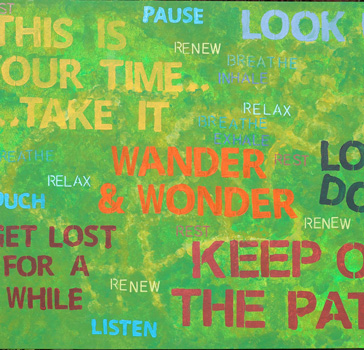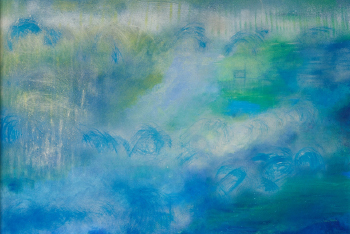Fragile with Attitude
‘Fragile with Attitude’ was an art exhibition held in the Great Oak Hall at Westonbirt Arboretum earlier this year in April 2022.
The exhibition was developed as part of the ‘Re-Storying Landscapes for Social Inclusion’ project with the University of Exeter; a project that aimed to inform landscape interpretation and decision-making that reflects and respects the diverse ways in which landscapes are sensed, valued and experienced over time.
‘Fragile with Attitude’ was curated by contemporary artist and creative consultant, Zoe Partington, in collaboration with Westonbirt Arboretum, Art Shape and six fantastic artists, including Naomi Said, Lisa Barnfield (the Green Lady), Chloë of the Midnight Storytellers, Eleanor May (Cat in the Moon), Julia Nigh (Duck & Dot), and mixed media abstract artist, Sarah Goddard.
Art Shape is an organisation that is passionate about supporting and enabling artists facing disabling barriers to realise their creative and learning potential.
You can read more about our artists here...
You can hear an introduction to the exhibition and view some of the work produced in this short video, produced by film-maker Chris Smart.
Download of video written description here
About the exhibition
Westonbirt is home to around 100 threatened tree species, including some of the rarest, ‘critically endangered' species such as the sapphire dragon tree and Madeira mountain ash tree.
Recognised as ecologically fragile, the lives of each individual tree at Westonbirt are celebrated as symbols of hope, as sources of shelter, oxygen, food – an integral part of the wider ecosystem. In turn, efforts are made to protect and restore the habitats they enrich and rely on globally to survive.
Yet, so often – and particularly since the Covid-19 pandemic – human lives deemed fragile are viewed as vulnerable or damaged. With illness, impairment and disability comes an assumption of inability, of a unique and separate form of weakness.
Rather than countering the social injustices that create unnecessary situations of vulnerability, disabled people are often segregated, pitied or dismissed.
In the words of influential scholar, Sara Ahmed:
“We need to develop a different orientation to breaking. We can value what is deemed broken; we can appreciate those bodies, those things, that are deemed to have bits and pieces missing. Breaking need not be understood only as the loss of the integrity of something, but as the acquisition of something else, whatever that else might be”.
‘Fragile with Attitude’ encouraged people to recognise more affirmative understandings of disability rooted in strength, collective experience and expertise.
Image 1: ‘Helping Hands’

Caption: ‘Helping Hands’ is a life-sized felted sculpture of forearms and hands. The arms are upright, in the style of a tree trunk, with the hands opening out at the top, like branches of a tree. At the base of the tree are felted pebbles in shades of grey, some are textured with open weave cotton fabric over the surface. The trunk of the tree (arms) is covered in brown shades of felt, highly textured, like bark. Some of this extends into the pebbles, as roots. At the wrists, the colour of the felt changes to shades of green. The same bark-like texture extends over the palms and backs of the hands. This piece was inspired by a Blue Atlas Cedar within the Arboretum. The shape of the branches reminded artist Eleanor May of arms reaching out, in a gesture of both offering and requesting help. This led her to think of the symbiotic relationship between humans and Nature. The piece is highly textured and invites the viewer to explore the many varied textures to be found within the Arboretum. Credit: Eleanor May.
Working alongside the six artists, Zoe Partington embedded the principles of the social model of disability in the development and curation of the exhibition. Through a series of sessions onsite and online, each artist found creative ways to ‘re-story’ the landscape through their own unique experiences.
Zoe explained:
“Disability Art is art made by disabled people, drawing upon a lived experience of disability. Disability Art has been recognised as a crucial component of the disability rights movement, informed by the social model of disability.
Disability Arts is about disabled people joining together. Through nurturing an affirmative self-identity, it gives us the confidence to promote the social change we want to see happen.
Creative interaction between disabled people involved in politics and disabled people involved in the arts fosters a collective identity, creating a new disability culture.
Proving that able-bodied people are not our role models. Providing control in how we are presented to others – a rounded picture of the reality of our lives. A celebration of difference”.
As a disabled artist and curator, Zoe emphasised the value of facilitating these artistic workshops in situ to enable disabled people to build landscape familiarity. The creative process can help to manage stress, anxiety and the unfamiliar in a non-conventional way. Disability Art is about flourishing in an environment that can benefit one’s identity and wellbeing. It enables each person to validate who they are, understand their human rights and avoid internalised ableism. Disabled people being visible, not only visually but intellectually, can help to break down institutional and societal barriers to participation.
Image 2: ‘Blue Mist in the Sky’

Caption: Produced by visual artist, creative consultant and exhibition curator, Zoe Partington, freely applied swirls of greens and blues cover the entire surface of this canvas, which measures approximately 1 metre square. The colours have the intensity of a peacock’s feathers, overpainted with chalky white, moving down to a dark patch of cobalt blue in the lower right-hand corner, so that the lighter colours above appear to hover. Traces of textured brushwork whip up the surface, scratched with fine lines and dizzying circles. The effect is mesmeric. Zoe calls this image “Blue Mist in the Air” but it could equally be the surface of a pond dappled with lily-pads reflecting blue skies above. Credit: Zoe Partington.
Reflecting on the experience, one of the artists, Sarah Goddard explained:
“I have felt like an imposter, as many of us do, whatever our field. But being a visually-impaired visual artist has felt oxymoronic and something I should hide. However, while working with other artists who face disabling barriers, I didn’t feel like the odd one out, having to explain access needs. This made me feel at ease, and freed me to concentrate on art from the start. Then throughout the project I came to further embrace my identity as a visually-impaired artist, and I believe that this has enabled me to create more authentic work. I am building on this to create art that more closely reflects how I experience the natural world.”
Image 3: ‘Keep Off the Paths’

Caption: Produced by mixed media artist, Sarah Goddard, ‘Keep Off the Paths’ is a large landscape-orientation acrylic painting with an abstract green background covered in stencilled writing in red, orange, yellow and blues. The background is painted in loose dabbed brush-strokes of bright greens, with more yellow marks to represent a map of the paths running through Westonbirt Arboretum. The stencilled text includes: “Keep off the paths” in red. “Get lost for a while” in red. “Wander and Wonder” in orange. “This is your time… … take it” in yellow. “Look up” in pale purplish-blue. “Look down” in dark blue. “Pause”, “Smell”, “Touch”, “Listen” in pale blue. Renew, relax, breathe, inhale, exhale multiple times in smaller font in shades of blues and yellows. This painting was inspired by a desire to encourage visitors not to treat the Arboretum as a formal garden, where they might be expected to keep to the paths, but rather to get close to the trees, to walk among them and gain as much as possible from the experience of being in nature. The stencilled messages on the painting are all prompts to engage mindfully with the arboretum. Credit: Sarah Goddard.
